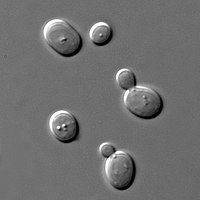
Photo from wikipedia
The amino acid biosynthetic pathway of invasive pathogenic fungi has been studied as a potential antifungal drug target. Studies of the disruption of genes involved in amino acid biosynthesis have… Click to show full abstract
The amino acid biosynthetic pathway of invasive pathogenic fungi has been studied as a potential antifungal drug target. Studies of the disruption of genes involved in amino acid biosynthesis have demonstrated the importance of this pathway in the virulence of Cryptococcus neoformans . Here, we identified the MET5 ( CNL05500 ) and MET10 ( CNG03990 ) genes in this pathway, both encoding sulfite reductase, which catalyzes the reduction of sulfite to sulfide. The MET14 ( CNE03880 ) gene was also identified, which is responsible for the conversion of sulfate to sulfite. The use of cysteine as a sulfur source led to the production of methionine via hydrogen sulfide synthesis mediated by CYS4 ( CNA06170 ) , CYS3 ( CNN01730 ), and MST1 ( CND03690 ). MST1 exhibited high homology with the TUM1 gene of Saccharomyces cerevisiae , which has functional similarity with the 3-mercaptopyruvate sulfurtransferase ( 3-MST ) gene in humans. Although the hypothesis that hydrogen sulfide is produced from cysteine via CYS4 , CYS3 , and MST1 warrants further study, the new insight into the metabolic pathway of sulfur-containing amino acids in C. neoformans provided here indicates the usefulness of this system in the development of screening tools for antifungal drug agents.
Journal Title: Current Genetics
Year Published: 2020
Link to full text (if available)
Share on Social Media: Sign Up to like & get
recommendations!